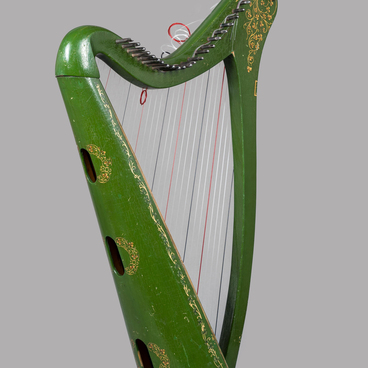This 19th-century seven-string guitar entered the museum’s collection in 1960. According to an expert assessment, the instrument was manufactured by a very skillful French craftsman. The guitar’s body is made of curly maple and covered with a light-brown lacquer, the soundboard is made of fine-grained resonant spruce, and the neck is made of ebony.
The guitar is decorated with a mosaic set, the soundboard and the front of the pegbox are inlaid with mother of pearl in the shape of flowers, birds, and tree branches. The massive wooden guitar case was manufactured in the first third of the 19th century, clad in rosewood, and lined with dark purple velvet on the inside.
The Moscow guitar builder and restorer Vasily Klimov said that the guitar was presented to Andrei Sychra by the ambassador of France to Russia. It was later converted into a seven-string instrument by the guitar builder Ivan Krasnoshchyokov. This story was written down by the guitar historian Vladimir Mashkevich. The document belongs to the museum’s collection of archive manuscripts.
Andrei Osipovich Sychra, a musician of Czech ancestry was born in Vilnius in 1773. He became a composer, teacher, and virtuoso guitarist. He published printed sheet music for the seven-string guitar in Moscow and Saint Petersburg. Over 150 of his publications have been preserved, including the issues of “The Saint Petersburg Guitar Magazine of Various Compositions, Easy on the Ear and Easy to Play.”
In fact, Andrei Sychra established the professional school of Russian guitarists with its own repertoire, performers, and composers. He wrote numerous compositions and took pleasure in working on opera arrangements.
In his latest years, he often wrote compositions for guitar duets. Sychra paid a lot of attention to the right-hand technique, and the students of his school in Saint Petersburg were distinguished by the great mastery of this aspect. He said,
The guitar is decorated with a mosaic set, the soundboard and the front of the pegbox are inlaid with mother of pearl in the shape of flowers, birds, and tree branches. The massive wooden guitar case was manufactured in the first third of the 19th century, clad in rosewood, and lined with dark purple velvet on the inside.
The Moscow guitar builder and restorer Vasily Klimov said that the guitar was presented to Andrei Sychra by the ambassador of France to Russia. It was later converted into a seven-string instrument by the guitar builder Ivan Krasnoshchyokov. This story was written down by the guitar historian Vladimir Mashkevich. The document belongs to the museum’s collection of archive manuscripts.
Andrei Osipovich Sychra, a musician of Czech ancestry was born in Vilnius in 1773. He became a composer, teacher, and virtuoso guitarist. He published printed sheet music for the seven-string guitar in Moscow and Saint Petersburg. Over 150 of his publications have been preserved, including the issues of “The Saint Petersburg Guitar Magazine of Various Compositions, Easy on the Ear and Easy to Play.”
In fact, Andrei Sychra established the professional school of Russian guitarists with its own repertoire, performers, and composers. He wrote numerous compositions and took pleasure in working on opera arrangements.
In his latest years, he often wrote compositions for guitar duets. Sychra paid a lot of attention to the right-hand technique, and the students of his school in Saint Petersburg were distinguished by the great mastery of this aspect. He said,





